Carbon (IV) oxide content of the atmosphere is least affected by
- A. cutting down and clearing of forests
- B. forest fires
- C. burning of fossil fuels
- D. plant and animal respiration
The number of plants species obtained from a population study of a garden is as follows: Guinea grass (15), Ipomea spp (5), sida spp (7) and Imperata spp (23). What is the percentage of occurrence of Imperata spp?
- A. 35%
- B. 16%
- C. 46%
- D. 23%
Salts and water are absorbed in the roots and transported to leaves by
- A. diffusion through the xylem tissues
- B. osmosis through the phloem tissues
- C. diffusion through the phloem tissues
- D. osmosis through the xylem tissues
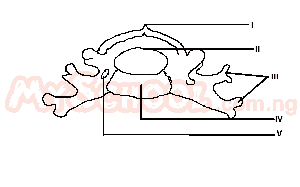
Blood vessel usually pass through the structure labelled
- A. III
- B. II
- C. V
- D. IV
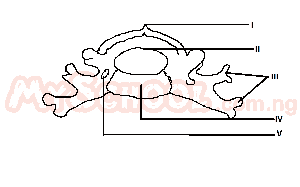
The structure above represents a
- A. caudal vertebra
- B. lumbar vertebra
- C. thoracic vertebra
- D. cervical vertebra
When specimen X is mixed with few drops of iodine solution, the appearance of a blue-black colour confirms that X is
- A. galactose
- B. starch
- C. sucrose
- D. glucose
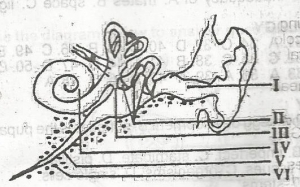
The part labelled II is the
- A. fenestra ovalis
- B. middle ear canal
- C. internal auditrory meatus
- D. ear ossicles
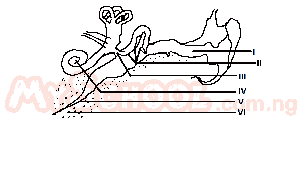
The parts which function together to bring about hearing are labelled
- A. IV, V and VI
- B. I, II, IV and VI
- C. I, II, III and IV
- D. I, II and IV
The veins of the leaf are formed by the
- A. vascular bundles
- B. cambium cells
- C. palisade tissue
- D. spongy mesophyll
The transportation of oxygen and carbon (IV) oxide in mammals is carried out by
- A. leucocytes
- B. thrombocytes
- C. phagocytes
- D. erythrocytes
When yeast respire anaerobically, it converts simple sugar to carbon (IV) oxide and
- A. oxygen
- B. acid
- C. alcohol
- D. water
The enzyme invertase will hydrolyze sucrose to give
- A. maltose and glucose
- B. glycerol and fatty acid
- C. glucose and fructose
- D. mannose and galactose
A seedling grown in the dark is likely to be
- A. etiolated
- B. dormant
- C. sturdy
- D. stunted
The gas produced during tissue respiration can be identified by using
- A. calcium hydroxide
- B. copper sulphate
- C. calcium carbonate
- D. sodium hydroxide
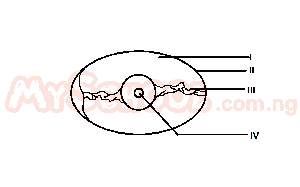
The part labelled IV is the
- A. albumen
- B. germinal disc
- C. yolk
- D. air space
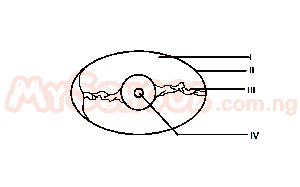
The structure that holds the yolk in position is labelled
- A. II
- B. I
- C. IV
- D. III
The center for learning and memory in the human brain is the
- A. medulla oblongata
- B. cerebellum
- C. cerebrum
- D. olfactory lobe
Which of the following organisms does not exist as a single free living cell?
- A. Paramecium
- B. Mold
- C. Amoeba
- D. Chlamydomonas
The mode of feeding in Amoeba and Hydra is
- A. heterotrophic
- B. holophytic
- C. autotrophic
- D. symbiotic
Water fleas, wood lice and barnacles belong to the group?
- A. arachnida
- B. crustacea
- C. insecta
- D. chilopoda


